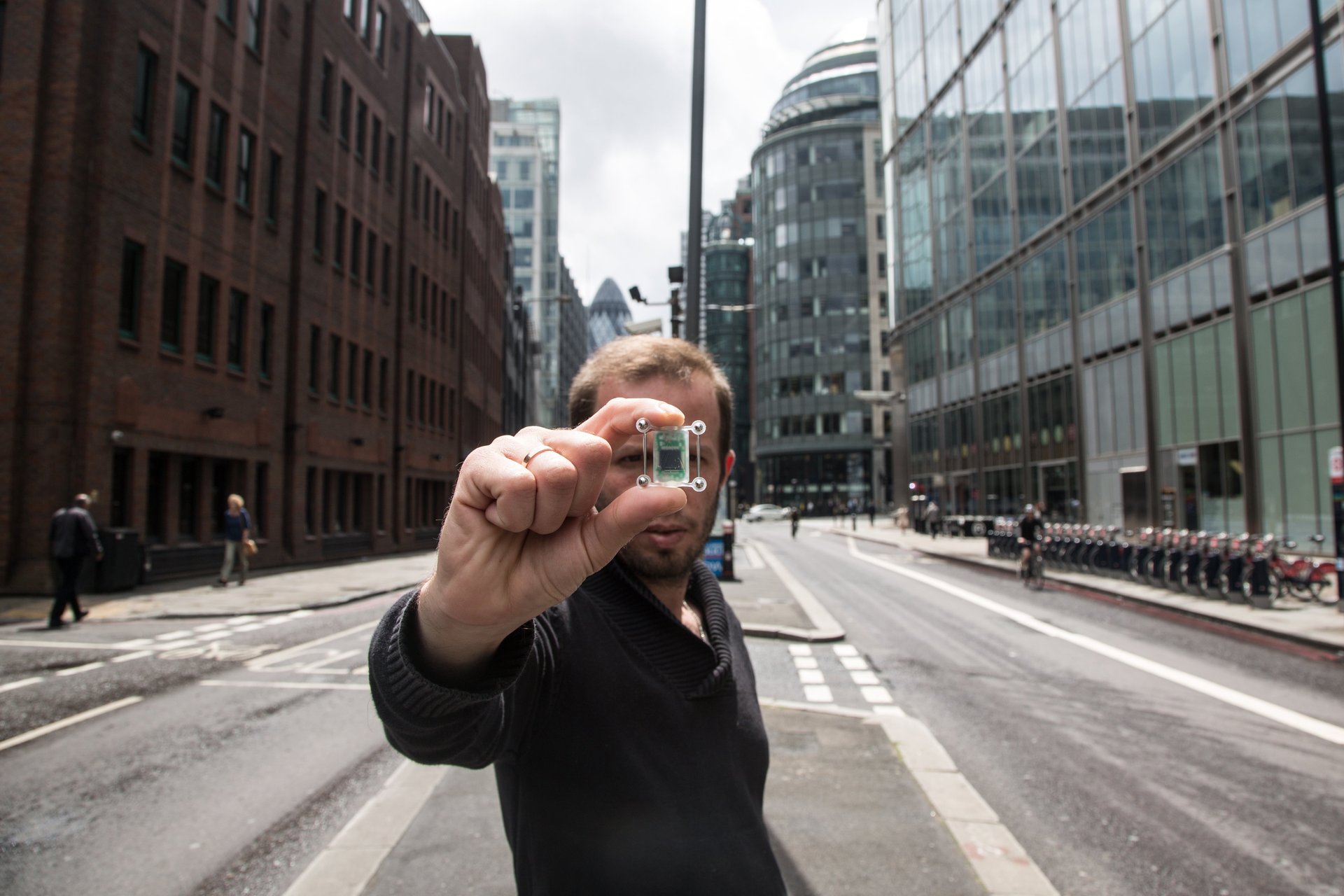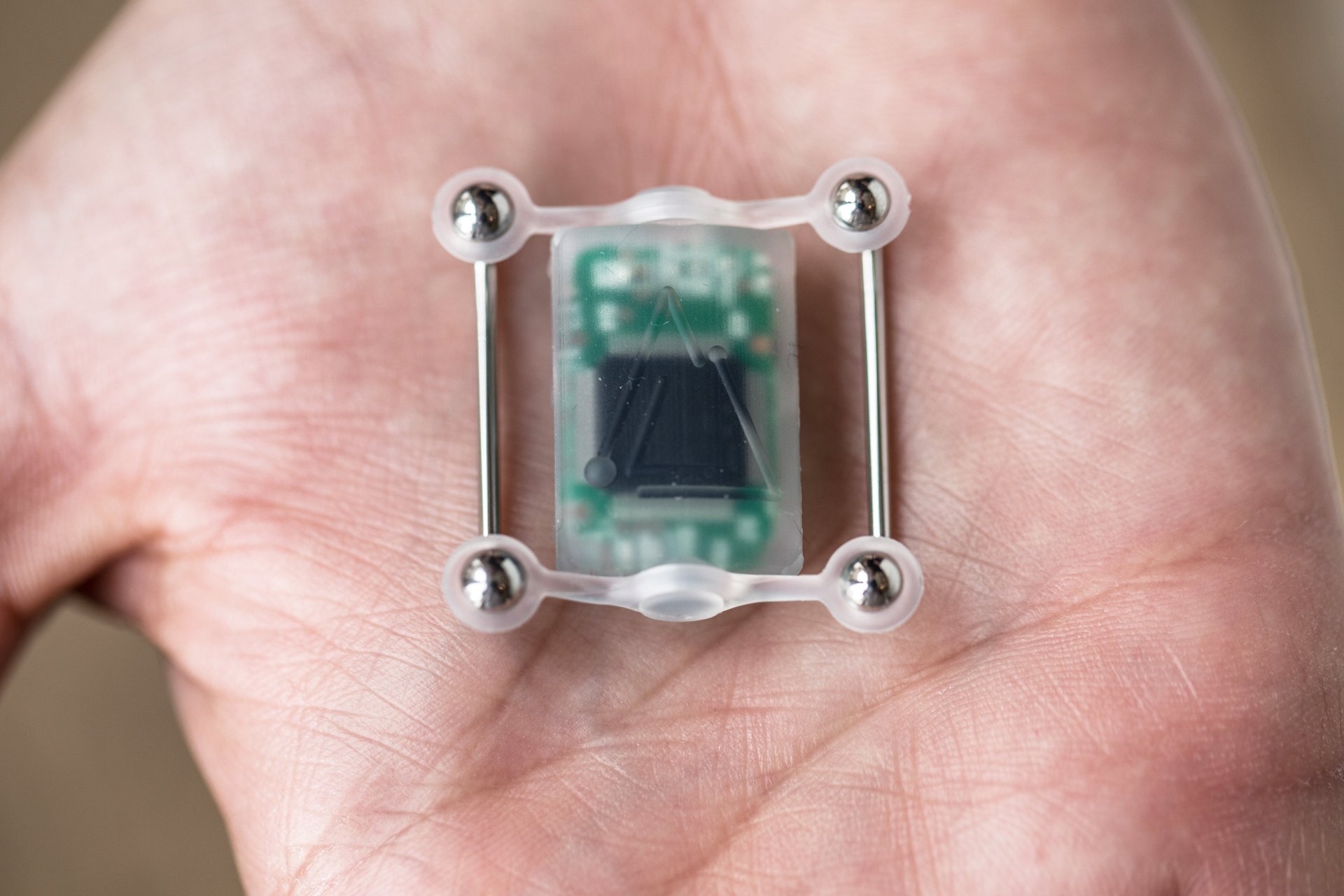This company will help you become a cyborg, one implanted sense at a time
Three years ago, Neil Harbisson, who is completely color-blind, had an antenna implanted in his skull that enables the artist and entrepreneur to sense color via audio vibrations. The long, metallic device, dubbed the ‘eyeborg,’ curves over the top of his head and hovers just above his eye line. It effectively made Harbisson into one of the world’s first cyborgs.


Three years ago, Neil Harbisson, who is completely color-blind, had an antenna implanted in his skull that enables the artist and entrepreneur to sense color via audio vibrations. The long, metallic device, dubbed the ‘eyeborg,’ curves over the top of his head and hovers just above his eye line. It effectively made Harbisson into one of the world’s first cyborgs.
Harbisson’s transformation was extensively covered by the media, and elicited correspondence from people all over the world interested in new senses. In response, he and a team of collaborators have launched Cyborg Nest, a company that aims to manufacture and sell implantable senses under the slogan “Design Your Evolution.” For £250 ($350) you can pre-order the UK-based company’s first product—the North Sense—and join the ranks of animal species that have the ability to sense the earth’s geomagnetic field and use it like a compass.

The North Sense is around a square inch in size and can be implanted superficially via dual titanium barbell piercings. The device has no buttons, screen, lights, or sounds. It simply vibrates when its wearer faces north. The team behind Cyborg Nest includes Harbisson’s childhood friend and fellow cyborg Moon Ribas, body modification expert Steve Haworth, CEO Liviu Babitz, and distributor Scott Cohen. Once testing is complete, Babitz and Cohen will be the first to implant the device and hope to be sensing north by August, after which shipping to customers will begin.
Technology has been influencing human sensory perception since the evolution from oral traditions to literacy prioritized visual communication over hearing, and information over everything. Recent experiments with Smell Dating, for example, highlight the nose’s historical importance in identifying a life partner. But these days we place more emphasis on statistics from dating websites than pheromones, and spend as much time touching our screens as we do each other.
The team behind Cyborg Nest wants to change that with technology that enhances our senses, or even gives us new ones.
Cyborg Evolution
Founded last year, Cyborg Nest’s origins can be traced back to the moment when Harbisson learned, at age 11, that he could only see in shades of black and white. “I never knew I couldn’t see color,” he says. “If someone asked me what was the color of the sky, I would look up at it and say ‘blue.’ I wasn’t seeing blue, but I didn’t know I wasn’t seeing blue.” The discovery sparked a curiosity about color that ultimately became a core focus of Harbisson’s life. He researched its physical properties and came across theories mapping the relationship between color and sound, then created his own color-to-sound scale as a way of understanding and interpreting color.
In 2003, Harbisson attended a lecture by digital futurist Adam Montandon on cybernetics (the word cyborg is a shortening of ‘cybernetic organism’). Realizing the potential of using technology to alter perception, Harbisson, then a student, approached Montandon and together they devised the eyeborg. It started out as a camera and headphones attached to a bulky computer that Harbisson carried around in a backpack, and soon evolved into a chip pressed against the back of his head.
At first the constant aural input from the eyborg caused headaches, but after five weeks they passed and the world became “an orchestra of sound,” Harbisson has written of the experience. “When I felt that the software and my brain had united, I started finding ways of creating a permanent body part, not a wearable device.”
Harbisson spent the next two years lobbying a bioethics committee at a Spanish hospital to surgically implant the antenna, only to have them ultimately reject his proposal. Finally, 10 years after first discussing the idea with Montandon, Harbisson found a young surgeon who shared his frontiersman spirit to do the surgery on the condition of anonymity, planting the device into the upper occipital bone of his skull. Today he can sense 360 color hues via 360 notes, as well as infrared and ultraviolet light.
When Harbisson created the eyeborg, Ribas, who grew up with Harbisson outside Barcelona, wanted to develop her own sense. Last year she had a chip implanted in her arm that enables her to feel the vibration of earthquakes around the world.
Therapeutic implants that effectively merge human and machine, such as pacemakers and artificial hips, are already a multi-billion dollar industry, but surgically implanted “senses” are largely a DIY phenomenon that occurs among a community of bio-hackers or ‘grinders’ experimenting with ways to overcome or enhance their biological limitations.
“I think eventually this is going to be something very useful, but right now it’s just a hobbyist or an aesthetic choice,” says Dr. James Hughes, executive director of the Institute for Ethics and Emerging Technologies in Connecticut. Lifestyle or productivity enhancements are more likely to take off once the size of the technology decreases, he says, because then implants will be less invasive. Hughes cites the development of nanorobotics as a potential turning point, something we could see by the 2030s. “The risk will be much smaller because these devices will be much smaller,” Hughes believes.
Future Designs
For now, Cyborg Nest is concentrating on creating new senses—including devices to detect certain kinds of pollution, expand human hearing beyond our current range, and provide new ways of sensing time—with technology that’s already available. But don’t expect to see new products on the market straight away. Babitz, the company’s CEO, acknowledges that it’s a process for people to even begin to get their head around the concept. That’s part of the reason they are starting out by merging new technologies with the somewhat more familiar art of body modification. “Legislation is not ready, health systems are not ready,” for Cyborg Nest’s vision of the future, Babitz says, and safety is a key priority. “We’re dealing with people’s bodies so there is a certain responsibility.”
A recent report surveying the top tech trends of 2016 suggests that people are beginning to embrace the idea, at least in theory. Ericsson ConsumerLab queried more than 6,000 smartphone users and found that 80% of respondents would like to augment their sensory perceptions and cognitive capabilities with technology. Cyborg Nest declined to share the number of pre-orders it has received for North Sense, but Babitz says the team has gotten positive responses from a diverse range of people.
“In the future maybe instead of asking, ‘What did you study? Where are you from?’ It will be, ‘What sense do you have? Or, ‘How do you experience the planet?’” says Ribas. “We always said that everybody can choose their own perception.”